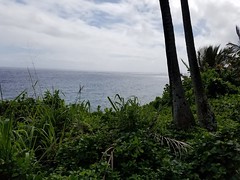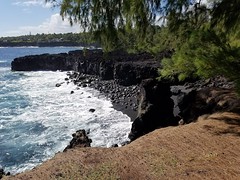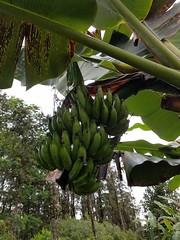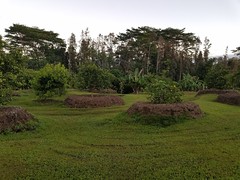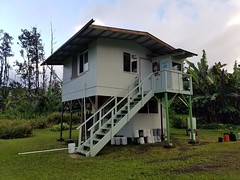I stayed at an organic fruit tree orchard in Hawaii for a month... This is what I learned
W.W.O.O.F stands for World Wide Opportunities on Organic Farms. Essentially, it's about connecting small organic farms with people who want to learn how to grow organic healthy food. You learn to farm by working a set number of hours in exchange for room and board. You can WWOOF almost anywhere on earth, which is awesome because WWOOFing makes the cost living while traveling ridiculously cheap.
I've always loved to travel different parts of the US, bouncing back and forth from my home state of southeast Florida, then up north to the metro Detroit area of Michigan, and out west to the bay area of California.
I always travel solo, not wanting anybody else's schedules, obligations or hesitations to stand between me and a good adventure.
I've also always enjoyed gardening, from growing veggies in the back yard to volunteering at local community gardens. So when I found out about an opportunity to learn organic farming while traveling to the tropical paradise of Hawaii, I jumped at that opportunity.
The WWOOF website has many organic farms available to crash at in exchange for a few hours of work. Each farm is different, but most expect 5 hours of work for 5 days a week in exchange for a place to sleep and free food. Accommodations vary, from a spare bedroom, a private cabin, or just a place to set up a tent. I made sure to find out as much as I could about what I was getting into
I found a 3 acre fruit tree orchard in the Hawaiian Acres subdivision of the Big Island of Hawaii. It had a modest off grid cabin, meaning no electric or water utilities. All electricity came from a single 240 watt solar panel, and non-potable water was gathered from the roof, filtered, and heated with propane for showers.
Drinking water was brought in from town in water containers.
I worked on 2 separate properties, the first being a well established 3 acre fruit tree orchard.
The second property is where I spent most of my effort. It was an untouched quarter acre that we were developing to become a new smaller farm.
I spent most of my effort transforming this empty lot into a fruit tree orchard
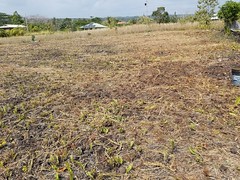
There are generally two (main) different types of lava rock on Hawaii. One is called "Pahoehoe" It takes the form of a basaltic lava forming smooth undulating slabs of hard lava rock, almost like asphalt. Since this kind of lava rock forms in large slabs, it is nearly impossible to dig through with mere hand tools.
An example of "Pahoehoe" lava rock by the ocean.
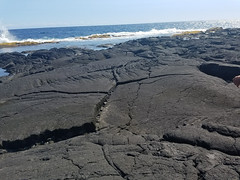
The second kind of lava rock is called "A'a". A'a lava looks completely different than pahoehoe lava, it takes the form of very sharp chunky rocks. A'a rock on the surface are very light weight, as they have many little holes and air pockets.
An example of "A'a" rock. I dug this hole in the rocks to plant a fruit tree.
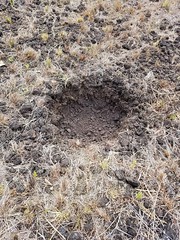
The process takes about 15 minutes or more to dig a hole big enough for a baby fruit tree (approximately 2 feet deep, by 3 feet around) it takes lots of patience, but that is the reality of farming on a lava field.
Of course, lava rocks aren't a terribly nutritious medium for trees to grow in. So I mixed two 5 gallon buckets of cinder-soil and two 5 gallon buckets of macadamia nut compost into the holes with the fruit tree.
Here is a baby banana tree growing in a medium of macadamia nut compost and cinder soil
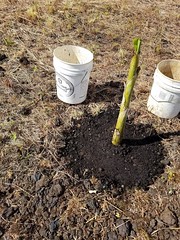
There are lots of macadamia nut orchards on the big Island of Hawaii, so macadamia nut shells are an abundant natural byproduct of this industry, perfect for composting with fruit trees. after each tree is planted, it needs to be fertilized. A couple of cups of dolomite and dried chicken manure pellets are sprinkled over the soil before the tree is covered with a deep layer of wood chip mulch.
This baby banana tree is mulched with wood-chips. It kinda looks like a flag
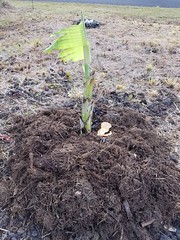
The mulch serves multiple purposes. It smothers out weeds around the tree, helps to retain moisture in the hot dry climate, and as the mulch eventually breaks down and decomposes, it's nutrients will leak down to feed the fruit tree roots.
...And finally, here are the 33 fruit trees I planted in the last 4 weeks living and working on the Big Island of Hawaii!
Click the arrows on the edges of the frame to scroll through the album and see all of the trees I planted!
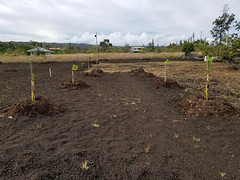
I would reccomend anyone who is interested in traveling and gardening to look into the WWOOF website and do some research.
I absolutely love planting trees, it is one of the most rewarding activities, especially fruit trees that will eventually provide an abundance of healthy organic food for decades to come in the future!
W.W.O.O.F stands for World Wide Opportunities on Organic Farms. Essentially, it's about connecting small organic farms with people who want to learn how to grow organic healthy food. You learn to farm by working a set number of hours in exchange for room and board. You can WWOOF almost anywhere on earth, which is awesome because WWOOFing makes the cost living while traveling ridiculously cheap.
I've always loved to travel different parts of the US, bouncing back and forth from my home state of southeast Florida, then up north to the metro Detroit area of Michigan, and out west to the bay area of California.
I always travel solo, not wanting anybody else's schedules, obligations or hesitations to stand between me and a good adventure.
I've also always enjoyed gardening, from growing veggies in the back yard to volunteering at local community gardens. So when I found out about an opportunity to learn organic farming while traveling to the tropical paradise of Hawaii, I jumped at that opportunity.
The WWOOF website has many organic farms available to crash at in exchange for a few hours of work. Each farm is different, but most expect 5 hours of work for 5 days a week in exchange for a place to sleep and free food. Accommodations vary, from a spare bedroom, a private cabin, or just a place to set up a tent. I made sure to find out as much as I could about what I was getting into
I found a 3 acre fruit tree orchard in the Hawaiian Acres subdivision of the Big Island of Hawaii. It had a modest off grid cabin, meaning no electric or water utilities. All electricity came from a single 240 watt solar panel, and non-potable water was gathered from the roof, filtered, and heated with propane for showers. Drinking water was brought in from town in water containers.
I worked on 2 separate properties, the first being a well established 3 acre fruit tree orchard.
The second property is where I spent most of my effort. It was an untouched quarter acre that we were developing to become a new smaller farm.
I spent most of my effort transforming this empty lot into a fruit tree orchard

There are generally two (main) different types of lava rock on Hawaii. One is called "Pahoehoe" It takes the form of a basaltic lava forming smooth undulating slabs of hard lava rock, almost like asphalt. Since this kind of lava rock forms in large slabs, it is nearly impossible to dig through with mere hand tools.
An example of "Pahoehoe" lava rock by the ocean.

The second kind of lava rock is called "A'a". A'a lava looks completely different than pahoehoe lava, it takes the form of very sharp chunky rocks. A'a rock on the surface are very light weight, as they have many little holes and air pockets.
An example of "A'a" rock. I dug this hole in the rocks to plant a fruit tree.

The process takes about 15 minutes or more to dig a hole big enough for a baby fruit tree (approximately 2 feet deep, by 3 feet around) it takes lots of patience, but that is the reality of farming on a lava field. Of course, lava rocks aren't a terribly nutritious medium for trees to grow in. So I mixed two 5 gallon buckets of cinder-soil and two 5 gallon buckets of macadamia nut compost into the holes with the fruit tree.
Here is a baby banana tree growing in a medium of macadamia nut compost and cinder soil

There are lots of macadamia nut orchards on the big Island of Hawaii, so macadamia nut shells are an abundant natural byproduct of this industry, perfect for composting with fruit trees. after each tree is planted, it needs to be fertilized. A couple of cups of dolomite and dried chicken manure pellets are sprinkled over the soil before the tree is covered with a deep layer of wood chip mulch.
This baby banana tree is mulched with wood-chips. It kinda looks like a flag

The mulch serves multiple purposes. It smothers out weeds around the tree, helps to retain moisture in the hot dry climate, and as the mulch eventually breaks down and decomposes, it's nutrients will leak down to feed the fruit tree roots.
...And finally, here are the 33 fruit trees I planted in the last 4 weeks living and working on the Big Island of Hawaii!
Click the arrows on the edges of the frame to scroll through the album and see all of the trees I planted!

I would reccomend anyone who is interested in traveling and gardening to look into the WWOOF website and do some research.
I absolutely love planting trees, it is one of the most rewarding activities, especially fruit trees that will eventually provide an abundance of healthy organic food for decades to come in the future!
